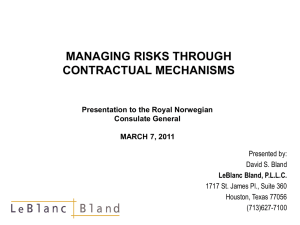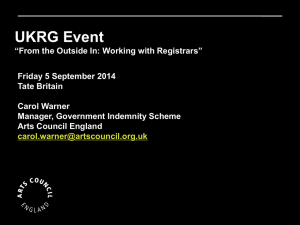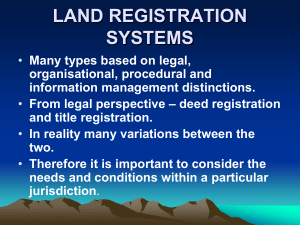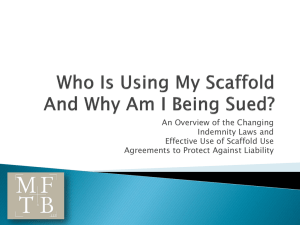Indemnity
advertisement
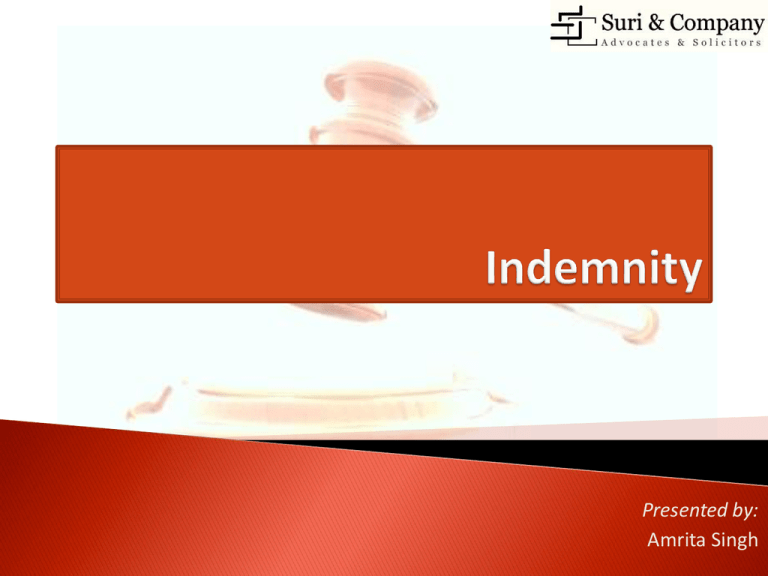
Presented by: Amrita Singh Relevant provisions of Indian Contract Act, 1872 Section 124 - “Contract of indemnity” defined Promise by the indemnifier to the indemnity holder Purpose of promise – To save the indemnity holder from loss caused to him Such loss may be caused by the conduct of the indemnifier or of any other person Section 125 - Rights of indemnity- holder when sued Preconditions: ◦ Existence of a contract of indemnity ◦ Indemnity holder should have acted within the scope of his authority Indemnity holder entitled to recover from the indemnifier – ◦ Damages ◦ All costs Provided: Indemnity holder did not contravene the orders of the indemnifier Indemnity holder acted prudently; or Indemnifier authorized indemnifier to bring/defend the suit ◦ Any compromise payment Provided: compromise is not contrary to the orders of the indemnifier Indemnity holder acted prudently Indemnifier authorized indemnity holder to compromise the suit It must be a valid contract under section 10 of Indian Contract Act: ◦ ◦ ◦ ◦ Free consent parties competent to contract lawful consideration, lawful object not expressly declared void Two parties: Loss to indemnity holder: ◦ Indemnifier (Promisor) ◦ Indemnity holder (Promisee) ◦ Occurrence of loss or damage is a contingency upon which liability of the indemnifier comes into existence. Indemnity Guarantee Contract of indemnity is a bilateral contract: Requires the concurrence of only two persons - the indemnifier and the indemnity holder. Contract of guarantee is a tripartite contract: Requires concurrence of three parties - the creditor, the surety and the principal debtor. Indemnifier is primarily independently liable. and There must be contract by which the principal debtor, expressly or impliedly requests the surety to act as surety. Indemnifier’s liability arises from loss caused by the conduct of indemnifier himself or by the conduct of another person. Surety’s liability arises from principal debtor’s default. Legal and equitable duty to indemnify Implied indemnity arises where the relation between the parties is such that either in law or in equity there is an obligation upon one party to indemnify the other. As expounded by Lord Halsbury in Sheffield Corporation v. Barclay 1905 AC 392 “It is a general principle of law when an Act is done by one person at the request of another which Act is not in itself manifestly tortuous to the knowledge of the person doing it, and such Act turns out to be injurious to the rights of a third party, the person doing it is entitled to an indemnity from him who requested that it should be done.” Chitty on Contracts, 22nd Edn., Vol. II, in Para, 1035, at p. 445 "In many cases the law implies a promise to indemnity. If the circumstances are such that the law imposes on any person a legal or equitable duty to indemnity, it will imply, a promise on his part to do that which under the circumstances he ought to do." Indian cases upholding the equitable principle of implied indemnity: •Secretary of State v. Bank of India Ltd. - AIR 1938 PC 191 •K.P.RM. Kuppan Chettiar Vs. SP.R.M.RM. Ramaswami Chettiar and Anr. - (1946)1MLJ383 •Joti Parshad Jai Gopal and Anr. Vs. Kartar Singh Sahib and Ors. - AIR1960P&H425 •Debabrata Ghose v. Jnanendra N. Ghose - AIR 1960 Cal 381 •Damodara Nayak Vs. Vatsala Nayak and Ors. - AIR1990Ker348 Earlier view based on English Common Law: ◦ No action can be maintained against the indemnifier till the indemnity holder has suffered actual loss. Present view based on equitable principles: ◦ Existence of a clear enforceable claim suffices to call indemnifier’s obligation into action. The indemnity holder compel the indemnifer to place him in a position to meet liability that may be cast upon him without waiting until he actually discharged it. the can the has Gajanan Moreshwar Parelkar Vs. Moreshwar Madan Mantri – AIR 1942 Bom 302 Sections 124 and 125 of the Indian Contract Act are not exhaustive of the law of indemnity. The Courts in India would apply the same equitable principles that the Courts in England do. “An indemnity might be worth very little indeed if the indemnified could not enforce his indemnity till he had actually paid the loss. If a suit was filed against him, he had actually to wait till a judgment was pronounced, and it was only after he had satisfied the judgment that he could sue on his indemnity. It is clear that this might under certain circumstances throw an intolerable burden upon the indemnity-holder. He might not be in a position to satisfy the judgment and yet he could not avail himself of his indemnity till he had done so. Therefore the Court of equity stepped in and mitigated the rigour of the common law.” Recent case laws: ◦ The New India Assurance Company Ltd. Vs. The State Trading Corporation of India Ltd. & Anr. – MANU/GJ/0001/2007 ◦ State Bank of India Vs. Moti Thawardas Dadlani and Ors. - (2007)109BOMLR483 Broad indemnity clause: “Contractor agrees to indemnify and hold harmless Owner from any and all liabilities, claims, actions, demands, losses, damages, penalties, lawsuits, judgments, including attorneys’ fees and costs, arising out of or relating to the work of Contractor.” The clause makes no accommodation for the possibility that someone else might also be responsible. Narrower version of indemnity clause: “Contractor agrees to indemnify and hold harmless Owner from any and all liabilities claims, actions, demands, losses, damages, lawsuits, judgments, including attorneys’ fees and costs, but only to the extent caused by, arising out of, or relating to the work of Contractor.” This additional language suggests an apportionment of relative fault. Capping of exposure: “In no event shall the maximum liability hereunder exceed the sum of Rs. _________. The limitation should bear a reasonable commercial relationship to the contract” Every indemnification clause is different so read it carefully - Don't assume that it is "standard" or "fair." Who is agreeing to pay who - Are you agreeing to pay the counter party if there is a problem or is the counter party agreeing to pay you? Don't go out of your way to offer indemnifications; it increases your potential risk. What kinds of losses will be covered - Will the indemnifier pay the attorneys' fees, Court costs and actual damages? Which party gets to control the legal strategy - Who is picking the attorney? Who gets to decide whether to settle the case? What kind of event triggers the obligation to indemnify - Breach of contract or negligence by the other party? Third-party claims? Is there a duty to defend - Does the contract require the indemnifier to assist in defending against a lawsuit, or does it merely require the indemnifier to pay for the financial losses? Never agree to indemnify the counter party against its own conduct -Indemnifications allocate risk to the party who is best able to prevent the risk of loss. Don't trust a client who asks you to indemnify its conduct. If you can't control the situation, don't agree to be liable for it. Indemnity provision should be integrated with the other risk allocation provisions in the contract – Include a clear dispute resolution mechanism. If the parties disagree over an indemnity claim, the dispute resolution mechanism will come into play. Insurance - If it is a long term contract and you have reasons to worry that the counter party may not have the resources to fulfill its indemnification obligations; it is advisable to require the counter party to have an adequate insurance to cover the risks involved. Being co-insured on target company insurance policies provides an additional security to the indemnified Limitation of liability – It is advisable to exclude consequential and remote damages from the scope of indemnity. Assignment of contract – If the contract is assigned, are the indemnity obligations also assigned? Indemnity holder’s duty to co-operate with the indemnifier – The indemnifier’s obligation can be made conditional to the indemnity holder promptly notifying the indemnifier of any claim in writing and cooperating with the indemnifier in the defense of the claim. Indemnity Bond is listed as Article 34 of the Indian Stamp Act Duty payable in Delhi: ◦ When the amount secured does not exceed Rs. 1000/- : 2% ◦ In other case: Rs.100/- When an agreement includes an indemnity clause, the stamp duty payable shall be: ◦ stamp duty payable on the agreement + stamp duty payable on an indemnity bond ◦ If the agreement is an agreement of sale, mortgage or settlement, stamp duty is payable only on the principal agreement and for the indemnity clause included therein a token stamp duty of Re.1 is payable. Any Queries??


